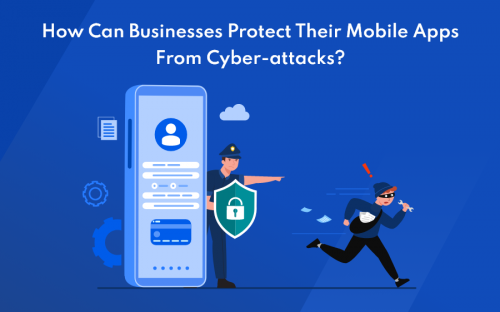
The total count of applications available on the Google Play Store and Apple App Store is more than 5 million. The availability of a bundle of developers and the modern applications launching each day has also improved the cyber security risks for mobile apps. As per research, over 75 percent of cross-platform mobile app development fail the basic security tests.
Technological improvements have swollen the figure of mobile phone users. The figure is poised to exceed 5 billion very soon. Mobile phones have made our lives comfortable, but it has also developed an accessible space for cybercriminals. They are leaking sensitive data in the public domain, stealing data, and attempting to cripple the complete ecosystem of mobile phones.
Cyber hackers are also having a ball as mobile application downloads are rising exponentially.
The money-maker of user data, including contact details, banking, and passwords, are eagerly accessible to hackers. They can also access emails, credit cards, and personal information quickly if you are utilizing a poorly secured mobile app.
With the lot accessible on these smartphone apps, they have become more prone to sophisticated and advanced cyber-attacks. A solo cyber-attack can belittle your business interests and expose your user information to anybody in the world.
So, before we discuss the techniques to secure mobile applications against cyber-attacks and how mobile threat defense solutions work, it is essential to talk about the main types of cyber-security threats.
Type of Main Cyber Security Threats
1. App Store Security
Over 90 percent of smartphones apps are prone to cyber-security attacks. Android devices are more inclined to these cyber-attacks because they cater to a massive range of devices, app store checks and operating system needs. Apple is more secure as it controls all the hardware & also provides the best access to the level of applications.
2. Cross-Device Cyber Attack
Cross-device attacks or threats occur when applications let mobile phone users download the app from the computer first & later to a mobile phone device.
3. IoT Hardware
We use IoT mobile applications to gather user data and utilize it for wise decision making. But Android enables the machine to make connections with other OS. This procedure raises security and can get out of hand at any moment.
4. Illegal Access
All of your digital accounts, including social media, bank, email, and other apps, are always visible to illegal access.
5. Mobile Malware
Mobile devices are always prone to -wares, viruses, Trojan attacks, spies and malware. These are direct means for attackers and hackers to steal the data.
6. One Device for Many Purposes
Persons at the corporate level always handle private and sensitive information. This hazardous data is always liable to the risk of having mixed with personal information if employees perform all tasks on the same device.
Any type of breach in the security of mobile applications can be disastrous for both developers and business owners.
Therefore, you need to be on your toes to handle advanced cyber-security attacks to keep your application secure from hackers.
How to Make Your Mobile Applications Safe from Dangerous Cyber Attacks?
1. Smartphone Device Management
Online security of the application relies mainly on the type of device the users are employing. Android or iOS, both OSs behave differently – and you require different methods for each OS to assure acceptable security. Professional developers at custom mobile app development companies must know that the data collected on any device is proficient in causing a security hole.
And this is where the encodings approach comprising 256-bit Advanced Encryption Standard arrives into play. It assists you in making the data safe in the form of files, databases, and other data formats. Furthermore, while finalizing the smartphone application cyber-security, it is crucial to consider encoding key management.
When we think about Apple, it has imposed a strict security strategy. It allows application owners to avoid any user from installing the application if they feel that something is wrong with the safety of the user’s device.
2. Design for Application Security
When you make up your mind to ensure your application’s end-to-end security, you must begin by making the threat model from the beginning. The best way should be to brainstorm as a hacker to find out all the loopholes. It will assist you in enforcing brassbound security measures. Moreover, you can take help from professional security guys who work like hackers to check the level of security and find out all the vulnerabilities.
The safety of the application becomes even more crucial when you need to run an eCommerce business with it. Just visualize the chances of the application getting hacked and sensitive user information, including bank account numbers, phone numbers, and credit details moving all over the Internet. Your most significant priority should be to secure sensitive user data at any price.
3. Application Wrapping
App Wrapping separates your mobile app from the residual devices by catching it in a safe zone. Professional developers who are utilizing MDM providers get this choice automatically. By placing some parameters, you can slice the application without writing any code.
4. Secured User Authentication
Implementing secured user authorization and authentication is essential for any mobile app’s security. It is imperative to start because an authentic user runs the application to avoid its access from malware and hackers.
While creating the user authentication, you should include all the crucial privacy points, session management, identity, and mobile safety features. MFA (multi-factor authentication) or 2FA (2-factor authentication) should be obligatory for stronger user authentication.
5. Confirm the Security of APIs
Always confirm to leverage APIs to manage all the business logic and data of the smartphone application. APIs guarantee data security in any situation, including at transit or static. It is one of the most severe features of any smartphone app.
Install SSL with 256-bit encryption to assure the security of data in transfer. And for static data, you can secure the device and origin both. Also, take care to use APIs that have application-level authentication. Preserve sensitive data fenced to the memory and ensure the authorized personality is using these services.
6. Get help from a Professional
To make your application safe and secure, we highly recommend you hire the best custom mobile app development company that keeps in mind all your concerns and offers you a highly secured app. Groovy Web is the best mobile app development agency using the latest tools and technologies to build the best competitive and secure app.
Conclusion
Bear in mind that before you step toward securing your mobile applications against hazardous cyber security threats, it is vital to identify what possible threats you are battling. After all, you cannot find a resolution without knowing the gist of the issue in the first place.
Once you find out the security threats troubling your smartphone app, it will be easier for you to handle the real danger. You can get Help from Groovy Web, the best mobile app development agency, to create the most secure and up-to-date mobile application.
Author’s Bio:

Krunal Panchal is the CEO & Co-founder of Groovy Web. He has been a hardcore programmer since he was 11 and started his professional career very young. His technical and logical mind drove him to choose coding as his destiny. At an initial stage, he got essential experience and the spirit of innovation and entrepreneurship. Learning something new is a never-ending process for him. Under his leadership, Groovy Web has become an established organization that serves industries from startups to enterprises, regardless of any limitations.
Interesting Related Article: ” The Importance Of Understanding Cyber Security“

